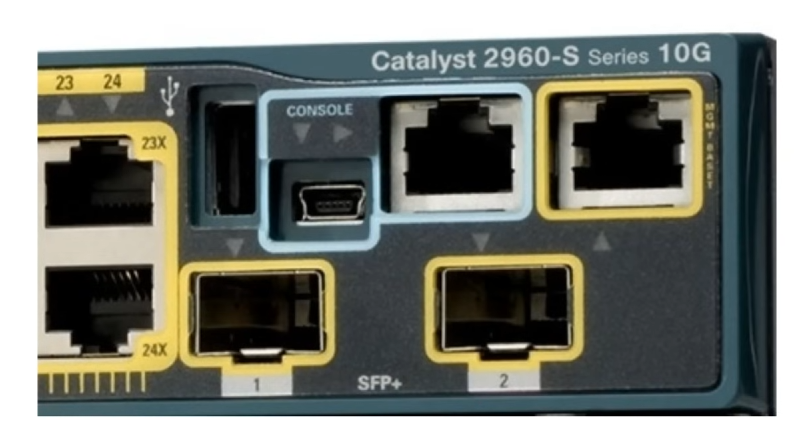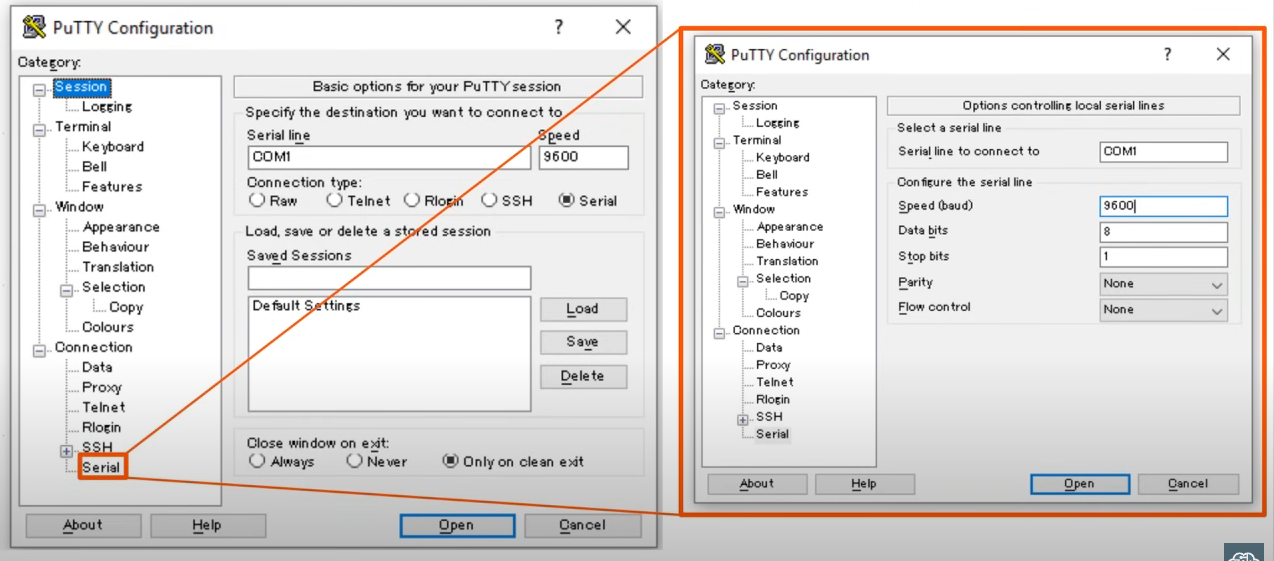ccna-notes
Intro to Cisco CLI
Table of contents
- Cisco IOS
- How to connect to a Cisco device
- CLI
- EXEC Modes
- Enabling Password
- running-config / startup-config
- Saving the configuration
- Password encryption
Cisco IOS
Operating system used on Cisco devices for configuration.
How to connect to a Cisco device
Console Port
This typically implies taking your laptop to the device and connecting to the console port of the device.

- when you first configure a device you have to connect to the console port.
- you need a
Rollover Cableto connect to your computer (and most likely an adapter)

Rollover cable PIN connections
1 --- 8
2 --- 7
3 --- 6
4 --- 5
5 --- 4
6 --- 3
7 --- 2
8 --- 1
Accessing the CLI
A terminal emulator is needed (i.e. Putty).
Default settings
The default settings are usually enough to connect to most devices, so for the purpose of CCNA we only care about the default values.
Speed (Baud rate) = 9600
Data bits = 8
Stop bits = 1
Parity = None
Flow control = None
where:
Speedis bits/s- for each 8
Data bitsof data 1Stop bitis sent Parity: used to detect errorsFlow control: controls the flow of data from transmitter to receiver

First-time boot greeting screen
```log System Bootstrap, Version 15.1(4)M4, RELEASE SOFTWARE (fc1) Technical Support: http://www.cisco.com/techsupport Copyright (c) 2010 by cisco Systems, Inc. Total memory size = 512 MB - On-board = 512 MB, DIMM0 = 0 MB CISCO2911/K9 platform with 524288 Kbytes of main memory Main memory is configured to 72/-1(On-board/DIMM0) bit mode with ECC disabled Readonly ROMMON initialized program load complete, entry point: 0x80803000, size: 0x1b340 program load complete, entry point: 0x80803000, size: 0x1b340 IOS Image Load Test ___________________ Digitally Signed Release Software program load complete, entry point: 0x81000000, size: 0x3bcd3d8 Self decompressing the image : ######################### [OK] Smart Init is enabled smart init is sizing iomem TYPE MEMORY_REQ Onboard devices & buffer pools 0x022F6000 ----------------------------------------------- TOTAL: 0x022F6000 Rounded IOMEM up to: 36Mb. Using 6 percent iomem. [36Mb/512Mb] Restricted Rights Legend Use, duplication, or disclosure by the Government is subject to restrictions as set forth in subparagraph (c) of the Commercial Computer Software - Restricted Rights clause at FAR sec. 52.227-19 and subparagraph (c) (1) (ii) of the Rights in Technical Data and Computer Software clause at DFARS sec. 252.227-7013. cisco Systems, Inc. 170 West Tasman Drive San Jose, California 95134-1706 Cisco IOS Software, C2900 Software (C2900-UNIVERSALK9-M), Version 15.1(4)M5, RELEASE SOFTWARE (fc2)Technical Support: http://www.cisco.com/techsupport Copyright (c) 1986-2007 by Cisco Systems, Inc. Compiled Wed 18-Jul-07 04:52 by pt_team Image text-base: 0x2100F918, data-base: 0x24729040 This product contains cryptographic features and is subject to United States and local country laws governing import, export, transfer and use. Delivery of Cisco cryptographic products does not imply third-party authority to import, export, distribute or use encryption. Importers, exporters, distributors and users are responsible for compliance with U.S. and local country laws. By using this product you agree to comply with applicable laws and regulations. If you are unable to comply with U.S. and local laws, return this product immediately. A summary of U.S. laws governing Cisco cryptographic products may be found at: http://www.cisco.com/wwl/export/crypto/tool/stqrg.html If you require further assistance please contact us by sending email to export@cisco.com. Cisco CISCO2911/K9 (revision 1.0) with 491520K/32768K bytes of memory. Processor board ID FTX152400KS 3 Gigabit Ethernet interfaces DRAM configuration is 64 bits wide with parity disabled. 255K bytes of non-volatile configuration memory. 249856K bytes of ATA System CompactFlash 0 (Read/Write) Press RETURN to get started! ```CLI
As shown in the following example, there is an autocomplete feature
Router>e
% Ambiguous command: "e"
Router>e?
enable exit
Router>en
Router#
To see how a command is used, you can add a ? at the end (notice the space before the question mark)
Router(config)#enable password?
password
Router(config)#enable password ?
7 Specifies a HIDDEN password will follow
LINE The UNENCRYPTED (cleartext) 'enable' password
level Set exec level password
Router(config)#
<cr> (carriage return) will be displayed when the only option is to press ENTER
Router(config)#enable password TEST ?
<cr>
Router(config)#
EXEC Modes
User EXEC Mode
- the name of the device is followed by a
>in this mode 🔥 - very limited
- can’t make changes to the config
- also called
user mode
Available commands
Router>?
Exec commands:
<1-99> Session number to resume
connect Open a terminal connection
disable Turn off privileged commands
disconnect Disconnect an existing network connection
enable Turn on privileged commands
exit Exit from the EXEC
logout Exit from the EXEC
ping Send echo messages
resume Resume an active network connection
show Show running system information
ssh Open a secure shell client connection
telnet Open a telnet connection
terminal Set terminal line parameters
traceroute Trace route to destination
Router>
Privileged EXEC Mode
If you enter the enable command in user mode you will be placed in Privileged EXEC Mode
Router>enable
Router#
- complete access to view device’s config, restart the device, etc
- cannot change config, only time on the device, save the config file, etc 🔥
Available commands
Router#?
Exec commands:
<1-99> Session number to resume
auto Exec level Automation
clear Reset functions
clock Manage the system clock
configure Enter configuration mode
connect Open a terminal connection
copy Copy from one file to another
debug Debugging functions (see also 'undebug')
delete Delete a file
dir List files on a filesystem
disable Turn off privileged commands
disconnect Disconnect an existing network connection
enable Turn on privileged commands
erase Erase a filesystem
exit Exit from the EXEC
logout Exit from the EXEC
mkdir Create new directory
more Display the contents of a file
no Disable debugging informations
ping Send echo messages
reload Halt and perform a cold restart
Router#
Global Configuration Mode
Router>enable
Router#configure terminal
Enter configuration commands, one per line. End with CNTL/Z.
Router(config)#
Enabling Password
Router>
Router>enable
Router#configure terminal
Enter configuration commands, one per line. End with CNTL/Z.
Router(config)#enable password TEST
Router(config)#exit
Router#
%SYS-5-CONFIG_I: Configured from console by console
Router#exit
Router>enable
Password:
Router#
running-config / startup-config
- There are the two config files kept on the device at any given time
running-config: active config file on the device. As you enter commands in the CLI, you edit the active config file.startup-config: config file that will be loaded upon restart of the device
show running-config
Router#show running-config
Building configuration...
Current configuration : 715 bytes
!
version 15.1
no service timestamps log datetime msec
no service timestamps debug datetime msec
no service password-encryption
!
hostname Router
!
!
!
enable password TEST
!
!
!
!
!
!
ip cef
no ipv6 cef
Router#
show startup-config
Router#show startup-config
Using 694 bytes
!
version 15.1
no service timestamps log datetime msec
no service timestamps debug datetime msec
no service password-encryption
!
hostname Router
!
!
!
!
!
!
!
!
ip cef
no ipv6 cef
!
!
!
!
Router#
Saving the configuration
There are 3 ways to save the configuration
-
writeRouter#write Building configuration... [OK] Router# -
write memoryRouter#write memory Building configuration... [OK] Router# -
copy running-config startup-configRouter#copy running-config startup-config Destination filename [startup-config]? Building configuration... [OK] Router#
Password encryption
Password are stored in plain text by default. 🔥🔥🔥
service password-encryption command
This commannd will use the 7 encryption algorithm for passwords, it is a proprietary encryption algorithm from Cisco.
7is NOT a secure encryption algorithm 🔥🔥🔥
Router(config)#service password-encryption
Router(config)#
-
show running-configBEFOREservice password-encryption:... enable password TEST ... -
show running-configAFTERservice password-encryption:... enable password 7 0815697D3D ...
enable secret command
This command will result in an MD5 encrypted password instead. Old passwords will remain in the config but will not be valid.
Router(config)#enable secret ANOTHERTEST
Router(config)#
-
show running-configAFTERenable secret:enable secret 5 $1$mERr$E6LHX/t.CDvQzXJY58S/l. enable password 7 0815697D3D